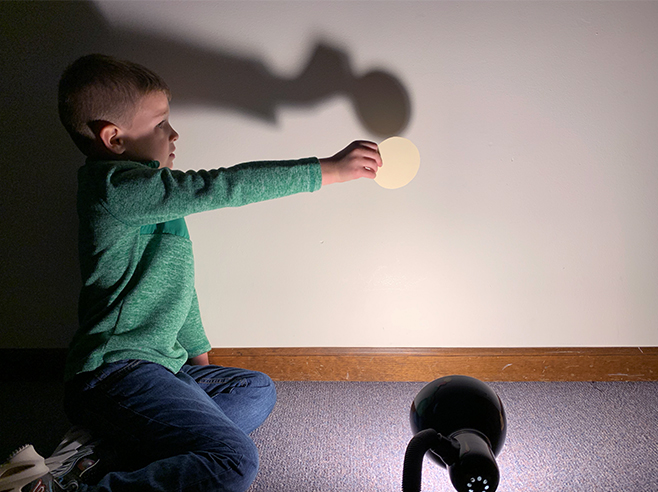Children identify and count the shapes on a shadow shape card and then build a matching shadow using cutouts of 2D shapes.
Materials

- Build a Shadow Cards #1–#2 (PDF)
- Shadow Shape Cutouts #1–#3 (PDF)
- Positional Words Chart (PDF)
- Cardstock paper
- Flashlights (or other light sources)
- Popsicle, craft, or paint sticks
- Shadows Journal camera tool (iPad)
- Tape (duct or masking)
- Optional: chart paper
Preparation
- Make three copies each of Shadow Shapes #1, #2, and #3 on heavy cardstock paper. (You may want to use fewer shapes if your children are just learning to identify shapes.) Cut out each shape and tape it on a popsicle stick handle. If you are unable to make copies on cardstock, print the shapes on paper, cut them out, and trace them onto cardstock.
- Make one copy of Build-a-Shadow Cards onto cardstock paper. Cut cards apart. Place them face down in a pile.
- Make a copy of the Positional Words Chart. Hang it in the shadow-making area.
- Place all the shadow materials in the shadow area. Have a flat surface available for casting shadows.
Directions: Lesson 10
Guided Small Group
- Invite children to explore the shape cutouts. Encourage children to observe the shapes. Possible discussion ideas:
- Can you name any of these shapes? (circle, square, oval, rectangle, star, triangle)
- How many (insert a shape name) do we have? Have children use the cards to count. Repeat for each shape.
- How is the (square) different from the (circle)?
- Shine the light on the shadow surface. Invite a child to hold a shape cutout between the light and the surface to make a shadow. Engage children in a discussion about shadows:
- How did you make the shadow appear? What is blocking the light?
- What happened to the light when it shone on the (shape name)?
- Have a child use a finger to trace around the cutout shape and its shadow. Encourage children to observe and compare. How are they the same? Different? Discuss how a shadow does not include details such as colors.
- Play Build-a-Shadow together. Have a child pull a card from the pile. As you play, engage in discussion:
- How many shapes do you see on the card? Count together.
- Can you find the shape cutouts that match the card?
- Read the shadow instructions on the card aloud. Have children build the shadow. Then have children take turns pulling a card, building the shadow, and taking a picture of the shadow. You may want to use the Positional Words Chart to help children visualize the different positions.
- As children explore, use science and math prompts to help them build and observe their shadows:
- Does your shadow have the same shapes as the card?
- What shape is next to the (oval) on the card?
- What shape is under the (star)? Is the (star) in the same position on the shadow surface as it is on the card?
- What happens to the shadow if you make the (squares) touch each other?
- Have children use the Shadows Journal’s Cool Shadows camera tool to take pictures of their group’s shadows.
Digital Learning Center
- Invite children to explore the Build-a-Shadow game in pairs or individually. Observe how children approach the game, including matching shapes, counting shapes, and positioning shapes to build a shadow. If needed, use prompts such as those used during earlier group explorations to engage children in science and math talk.
- Prompt children to listen to and build on each other’s ideas.
- Encourage children to use the Shadows Journal’s Cool Shadows camera tool to take pictures of their shadows.
Directions: Lesson 11
Digital Learning Center
- Invite children to explore the Build-a-Shadow game in pairs or individually. Observe how children approach the game, including matching shapes, counting shapes, and positioning shapes to build a shadow. If needed, use the prompts below or those used during earlier group explorations to engage children in science and math talk.
- How did you build that shadow? How many shapes did you use?
- What shape is over the (triangle)?
- What do you think will happen to the shadow if you overlap the shapes?
- What would happen if you moved the shape out of the light?
- Encourage pairs to review the photos taken in Guided Small Groups with the Cool Shadows camera tool. Ask them to describe how the shadows were made.
- Prompt children to listen to and build on each other’s ideas.
- Encourage children to use the Shadows Journal’s Cool Shadows camera tool to take pictures of their shadows. Possible discussion ideas:
- How did you build that shadow? How many shapes did you use?
- What shape is over the (star)? Can you find the card that matches that shadow?
- What do you think will happen to the shadow if you overlap the shapes?
- What would happen if you moved the shape out of the light?
- Hold the flashlight and encourage volunteers to build the shadow you are discussing.


